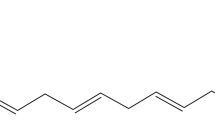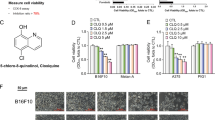Abstract
Previous studies have indicated the antitumoral effect of human melanocytes, human melanoma cell lines expressing CB1 receptor (CB1), and of the peritumoral administration of endocannabinoids. In the present study, we systematically screened several human melanoma cell lines for the expression of CNR1 and demonstrated transcription of the authentic gene. The product of CNR1, the CB1 protein, was found localized to the cell membrane as well as to the cytoskeleton. Further, the studied human melanoma cell lines expressed functional CB1 since physiological and synthetic ligands, anandamide (AEA), Met-F-AEA, ACEA and AM251 showed a wide range of biological effects in vitro, for example anti-proliferative, proapoptotic and anti-migratory. More importantly, our studies revealed that systemic administration of a stable CB1 agonist, ACEA, into SCID mice specifically inhibited liver colonization of human melanoma cells. Since therapeutic options for melanoma patients are still very limited, the endocannabinoid-CB1 receptor system may offer a novel target.





Similar content being viewed by others
Abbreviations
- 2-AG:
-
2-arachidonoylglycerol
- A:
-
Adenosine
- ACEA:
-
Arachidonyl-2-chloroethylamide
- AEA:
-
Anandamide
- AKT:
-
Protein kinase B
- AM251:
-
N-piperidinyl-iodophenyl-dichlorophenyl-methylpyrazole-carboxamide
- BSA:
-
Bovine serum albumin
- C:
-
Cytosine
- Ca:
-
Calcium
- CB:
-
Cannabinoid
- CB1:
-
Cannabinoid receptor 1
- CB2:
-
Cannabinoid receptor 2
- CNR1:
-
Gene of cannabinoid receptor 1
- cDNA:
-
Complementary deoxyribonucleic acid
- DEPC:
-
Diethylpyrocarbonate
- DMSO:
-
Dimethyl sulfoxide
- DNA:
-
Deoxyribonucleic acid
- COX:
-
Cyclooxygenase
- EDTA:
-
Ethylenediaminetetraacetic acid
- FAAH:
-
Fatty acid amide hydrolase
- FCS:
-
Fetal calf serum
- FITC:
-
Fluorescein isothiocyanate
- G:
-
Guanine
- GPCR:
-
G protein-coupled receptor
- IC50:
-
Half maximal inhibitory concentration
- IFN:
-
Interferon
- IL:
-
Interleukin
- LOX:
-
Lipooxygenase
- MAGL:
-
Monoacylglycerol lipase
- MAPK:
-
Mitogen-activated protein kinase
- Met-F-AEA:
-
2-methyl-2-fluoro-anandamide
- mTOR:
-
Mammalian target of rapamycin
- MTT:
-
Thiazolyl blue tetrazolium bromide
- P:
-
Probability
- PBS:
-
Phosphate-buffered saline
- PCR:
-
Polymerase chain reaction
- PI:
-
Propidium iodide
- PI3K:
-
Phosphatidylinositol-3 kinase
- RAF:
-
RAF oncogene
- RAS:
-
RAS oncogene
- Rb:
-
Retinoblastoma
- RNA:
-
Ribonucleic acid
- SCID:
-
Severe combined immunodeficiency
- T:
-
Thymine
References
Wang J, Ueda N (2009) Biology of endocannabinoid synthesis system. Prostaglandins Other Lipid Mediat 89:112–119
Flygare J, Sander B (2008) The endocannabinoid system in cancer-potential therapeutic target? Semin Cancer Biol 18:176–189
Mouslech Z, Valla V (2009) Endocannabinoid system: an overview of its potential in current medical practice. Neuro Endocrinol Lett 30:153–179
Bifulco M, Di Marzo V (2002) Targeting the endocannabinoid system in cancer therapy: a call for further research. Nat Med 8:547–550
Alexander A, Smith PF, Rosengren RJ (2009) Cannabinoids in the treatment of cancer. Cancer Lett 285:6–12
Alpini G, Demorrow S (2009) Changes in the endocannabinoid system may give insight into new and effective treatments for cancer. Vitam Horm 81:469–485
Fowler CJ, Gustafsson SB, Chung SC et al (2010) Targeting the endocannabinoid system for the treatment of cancer–a practical view. Curr Top Med Chem 10:814–827
Bifulco M, Malfitano AM, Pisanti S et al (2008) Endocannabinoids in endocrine and related tumours. Endocr Relat Cancer 15:391–408
Portella G, Laezza C, Laccetti P et al (2003) Inhibitory effects of cannabinoid CB1 receptor stimulation on tumor growth and metastatic spreading: actions on signals involved in angiogenesis and metastasis. FASEB J 17:1771–1773
Pisanti S, Bifulco M (2009) Endocannabinoid system modulation in cancer biology and therapy. Pharmacol Res 60:107–116
Bifulco M, Laezza C, Gazzerro P et al (2007) Endocannabinoids as emerging suppressors of angiogenesis and tumor invasion (review). Oncol Rep 17:813–816
Sarfaraz S, Afaq F, Adhami VM et al (2005) Cannabinoid receptor as a novel target for the treatment of prostate cancer. Cancer Res 65:1635–1641
Gazzerro P, Malfitano AM, Proto MC et al (2010) Synergistic inhibition of human colon cancer cell growth by the cannabinoid CB1 receptor antagonist rimonabant and oxaliplatin. Oncol Rep 23:171–175
Biro T, Toth BI, Hasko G et al (2009) The endocannabinoid system of the skin in health and disease: novel perspectives and therapeutic opportunities. Trends Pharmacol Sci 30:411–420
Casanova ML, Blazquez C, Martinez-Palacio J et al (2003) Inhibition of skin tumor growth and angiogenesis in vivo by activation of cannabinoid receptors. J Clin Invest 111:43–50
Blazquez C, Carracedo A, Barrado L et al (2006) Cannabinoid receptors as novel targets for the treatment of melanoma. FASEB J 20:2633–2635
Sosman JA, Puzanov I (2006) Molecular targets in melanoma from angiogenesis to apoptosis. Clin Cancer Res 12:2376s–2383s
Denkert C, Kobel M, Berger S et al (2001) Expression of cyclooxygenase 2 in human malignant melanoma. Cancer Res 61:303–308
Tabolacci C, Lentini A, Provenzano B et al (2010) Similar antineoplastic effects of nimesulide, a selective COX-2 inhibitor, and prostaglandin E1 on B16-F10 murine melanoma cells. Melanoma Res 20:273–279
Liu B, Khan WA, Hannun YA et al (1995) 12(S)-hydroxyeicosatetraenoic acid and 13(S)-hydroxyoctadecadienoic acid regulation of protein kinase C-alpha in melanoma cells: role of receptor-mediated hydrolysis of inositol phospholipids. Proc Natl Acad Sci U S A 92:9323–9327
Raso E, Dome B, Somlai B et al (2004) Molecular identification, localization and function of platelet-type 12-lipoxygenase in human melanoma progression, under experimental and clinical conditions. Melanoma Res 14:245–250
Ladanyi A, Timar J, Paku S et al (1990) Selection and characterization of human melanoma lines with different liver-colonizing capacity. Int J Cancer 46:456–461
Dome B, Raso E, Dobos J et al (2005) Parallel expression of alphaIIbbeta3 and alphavbeta3 integrins in human melanoma cells upregulates bFGF expression and promotes their angiogenic phenotype. Int J Cancer 116:27–35
Deli T, Varga N, Adam A et al (2007) Functional genomics of calcium channels in human melanoma cells. Int J Cancer 121:55–65
Grimaldi C, Pisanti S, Laezza C et al (2006) Anandamide inhibits adhesion and migration of breast cancer cells. Exp Cell Res 312:363–373
Ramer R, Hinz B (2008) Inhibition of cancer cell invasion by cannabinoids via increased expression of tissue inhibitor of matrix metalloproteinases-1. J Natl Cancer Inst 100:59–69
Hersey P, Zhuang L, Zhang XD (2006) Current strategies in overcoming resistance of cancer cells to apoptosis melanoma as a model. Int Rev Cytol 251:131–158
Eberle J, Fecker LF, Hossini AM et al (2008) Apoptosis pathways and oncolytic adenoviral vectors: promising targets and tools to overcome therapy resistance of malignant melanoma. Exp Dermatol 17:1–11
La Porta CA (2009) Mechanism of drug sensitivity and resistance in melanoma. Curr Cancer Drug Targets 9:391–397
Sarnataro D, Grimaldi C, Pisanti S et al (2005) Plasma membrane and lysosomal localization of CB1 cannabinoid receptor are dependent on lipid rafts and regulated by anandamide in human breast cancer cells. FEBS Lett 579:6343–6349
Osborne KD, Lee W, Malarkey EB, et al (2009) Dynamic imaging of cannabinoid receptor 1 vesicular trafficking in cultured astrocytes. ASN Neuro 1.
Bari M, Oddi S, De Simone C et al (2008) Type-1 cannabinoid receptors colocalize with caveolin-1 in neuronal cells. Neuropharmacology 54:45–50
Engelman JA (2009) Targeting PI3K signalling in cancer: opportunities, challenges and limitations. Nat Rev Cancer 9:550–562
Liu P, Cheng H, Roberts TM et al (2009) Targeting the phosphoinositide 3-kinase pathway in cancer. Nat Rev Drug Discov 8:627–644
Madhunapantula SV, Robertson GP (2009) The PTEN-AKT3 signaling cascade as a therapeutic target in melanoma. Pigment Cell Melanoma Res 22:400–419
Hudes GR, Berkenblit A, Feingold J et al (2009) Clinical trial experience with temsirolimus in patients with advanced renal cell carcinoma. Semin Oncol 36(Suppl 3):S26–S36
Porta C, Figlin RA (2009) Phosphatidylinositol-3-kinase/Akt signaling pathway and kidney cancer, and the therapeutic potential of phosphatidylinositol-3-kinase/Akt inhibitors. J Urol 182:2569–2577
European public assessment report. Acomplia. http://www.ema.europa.eu/docs/en_GB/document_library/EPAR_-_Summary_for_the_public/human/000666/WC500021282.pdf.
Acknowledgments
This work was supported by TAMOP 4.2.1b, OTKA-NK72595 (JTi) and OTKA-K84173 (JTó).
Author information
Authors and Affiliations
Corresponding author
Additional information
István Kenessey and Balázs Bánki equal contribution.
Rights and permissions
About this article
Cite this article
Kenessey, I., Bánki, B., Márk, Á. et al. Revisiting CB1 Receptor as Drug Target in Human Melanoma. Pathol. Oncol. Res. 18, 857–866 (2012). https://doi.org/10.1007/s12253-012-9515-y
Received:
Accepted:
Published:
Issue Date:
DOI: https://doi.org/10.1007/s12253-012-9515-y




